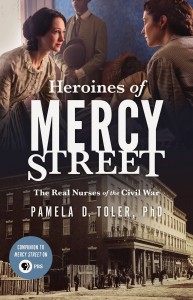The Challenges of Writing Women’s History
 When I began work on Heroines of Mercy Street I assumed that there were already lots of books on the subject and I feared that there wouldn’t be anything new for me to say. After all, everyone knew what Civil War nurses looked like, right?
When I began work on Heroines of Mercy Street I assumed that there were already lots of books on the subject and I feared that there wouldn’t be anything new for me to say. After all, everyone knew what Civil War nurses looked like, right?
In fact, I was wrong on both counts. Nurses on the Clara Barton (and now Mary Phinney) model turned out to be only a small portion of the women who nursed in the Civil War. And there were very few books on the subject: one or two good scholarly works written over the last ten years or so and a couple of popular works dating from the 1950s. Otherwise, Civil War nurses were limited to a chapter (or a paragraph) in a book about Civil War medicine or the broader involvement of women in the war.
Quite frankly, I thought I was screwed.
This isn’t a problem unique to the women I wrote about. Writing about women in history brings with it a special set of challenges. All too often women relegated to the footnotes, brushed aside as “semi-legendary,”* or ignored altogether. Their contributions are erased. Primary sources are rare, or nonexistent, or dismissed as “questionable”. They are buried in archives, or classified as a subset of documents related to a male relative or acquaintance.
In the case of my Civil War nurses, I was lucky. I discovered a source that I hadn’t realized existed. I had known that many soldiers wrote about their experiences, but I didn’t realize that nurses on both sides of the also wrote memoirs. ** Not all of them were written for publication. Some were privately published for the benefit of their families. (“What did you do in the war, Grandma?”) Some were written as part of the attempt to get war pensions for nurses. They were funny. They were heartbreaking. They were opinionated. I had struck gold.
 Now I realize more than ever just how lucky I was to have stories told by the nurses themselves. I’m working on a global history of women warriors and I’m pretty sure that women warriors in ancient China didn’t write memoirs.
Now I realize more than ever just how lucky I was to have stories told by the nurses themselves. I’m working on a global history of women warriors and I’m pretty sure that women warriors in ancient China didn’t write memoirs.
*This doesn’t just happen in the case of women from the misty ancient past. In the last week I’ve seen that description attached to a sixteenth century African queen and an eighteenth century American heroine.
** This is, by the way, a perfect example of how women vanish from history even when they’re in plain sight. I knew about the soldiers’ memoirs because they were part of an outpouring of war related writing that appeared about twenty years after the war. The scholarly works that describe this phenomenon did not include works by nurses in their long lists of publications. And because they weren’t included in these very good scholarly works, it never occurred to me that such works existed. Lesson learned.
—
Pamela D. Toler is a freelance writer with a PhD in history and a fascination with historical figures who step outside the constraints of their time. Her official field is South Asian history, but on any given day she could be writing about Siberian reindeer hair embroidery, World War I recruiting posters, pyramid cults, the mud mosques of West Africa, the first translation of the Arabian Nights, Napoleon’s invasion of Egypt, or tough broads from the past.
She is the author of a middle-grade biography of Matt Damon, Mankind: The Story of All of Us, The Everything Guide to Socialism, and most recently Heroines of Mercy Street: The Real Nurses of the Civil War. She is currently writing a global history of women warriors, with the imaginative working title of Women Warriors.
BUY HEROINES OF MERCY STREET HERE
Find out more about Pamela on her website http://www.historyinthemargins.com/
About Heroines of Mercy Street: The Real Nurses of the Civil War
The true stories of the real nurses on the PBS show Mercy Street
The nurses of the Civil War ushered in a new era for medicine in the midst of tremendous hardship. While the country was at war, these women not only learned to advocate and care for patients in hostile settings, saved countless lives, and changed the profession forever, they regularly fell ill with no one to nurse them in return, seethed in anger at the indifference and inefficiency that left wounded men on the battlefield without care, and all too often mourned for those they could not rescue.
Heroines of Mercy Street tells the true stories of the nurses at Mansion House, the Alexandria, Virginia, hotel turned wartime hospital and setting for the PBS show Mercy Street. Women like Dorothea Dix, Mary Phinney, Anne Reading, and more rushed to be of service to their country during the war, meeting challenges that would discourage less determined souls every step of the way. They saw casualties on a scale Americans had never seen before; diseases like typhoid and dysentery were rampant; and working conditions-both physically and emotionally–were abysmal.
Drawing on the diaries, letters, and books written by these nursing pioneers, Pamela D. Toler, PhD, has written a fascinating portrait of true heroines, shining a light on their personal contributions during one of our country’s most turbulent periods.
Category: Contemporary Women Writers, How To and Tips

























